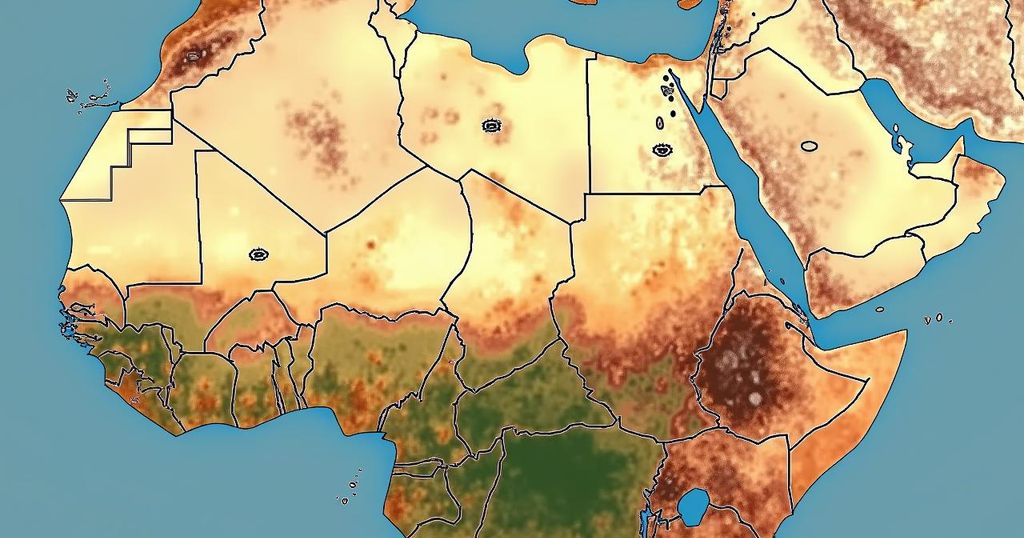Since 2008, floods have caused over 185 million internal displacements worldwide, with Africa experiencing around 29 million. This report focuses on the Horn of Africa, particularly Sudan, Ethiopia, and Somalia, and introduces a new flood displacement risk model developed through the HABITABLE project. This model aims to improve predictions of future displacements using a unique vulnerability assessment and a probabilistic approach. The results suggest a potential increase in average annual displacement, highlighting the need for informed disaster risk reduction strategies and comprehensive policies to tackle flood-induced displacement risks.
This report presents alarming findings regarding the impact of flooding on internal displacement within Africa, detailing that since 2008, floods have resulted in over 185 million cases of forced movement globally, with approximately 29 million of these incidents occurring in Africa alone between 2008 and 2022, thus making it the second most affected region. Concentrating on the Horn of Africa, specifically Sudan, Ethiopia, and Somalia, the study introduces an innovative flood displacement risk model developed as part of the HABITABLE project’s Work Package 3. This model is designed to provide calibrated predictions of future displacement movements, essential for effective policy formulation. The methodology employed involves a sophisticated vulnerability assessment that factors in critical impacts often overlooked in traditional models. This assessment addresses both direct consequences on residential structures and livelihoods as well as indirect effects on vital facilities and services. Utilizing a probabilistic approach, the study integrates various modelling techniques—climatic, hydrological, and hydraulic—to accurately assess the impacts that trigger displacement. By leveraging cutting-edge technologies and the new vulnerability assessment framework, the research quantifies displacement risk through metrics of average annual displacement (AAD) and the probable maximum displacement. Evaluations conducted under current and anticipated future climate scenarios reveal a concerning potential increase in average annual displacement by two to four times in comparison to current levels. In pessimistic projections, this risk escalates even further, with Sudan facing an anticipated ninefold surge in displacement risk. The findings aim to support national and subnational disaster risk reduction strategies, facilitating the identification of regions susceptible to large-scale displacements. Policymakers can utilize this crucial information to execute risk-informed initiatives aimed at preventing and mitigating the adverse effects of displacement. In conclusion, the report emphasizes the necessity for broad-ranging policies and strategies to address the risks associated with flood-induced displacement and the imperative need to safeguard vulnerable populations.
In recent years, the Horn of Africa has increasingly faced the dual threats of floods and droughts, leading to significant humanitarian crises and internal displacement. The region has been the focus of various studies that aim to understand the environmental and social dynamics contributing to people’s forced movements. This report builds on existing knowledge by introducing an advanced model for assessing flood displacement risk specifically tailored to the contexts of Ethiopia, Sudan, and Somalia. The context of climate change, increasing population pressures, and inadequate infrastructures raises the stakes for effective risk management strategies in these vulnerable regions. Understanding these complex interactions helps frame pragmatic solutions that can mitigate future displacements and protect communities.
This report delineates the pressing issue of flood-induced internal displacement in the Horn of Africa, with a significant emphasis on Sudan, Ethiopia, and Somalia. The implementation of a novel flood displacement risk model presents critical insights into predicting future movements and emphasizes the need for comprehensive disaster risk reduction policies. With projections indicating a potential exacerbation of displacement risks, it is paramount for decision-makers to adopt data-driven approaches to safeguard affected populations. The implications of this study underline the urgency of strategic planning and intervention to adapt to the consequences of climate change and promote resilience in the region.
Original Source: reliefweb.int






